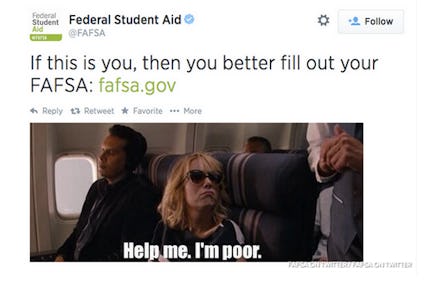In One Tweet, the Government Insulted College Students Everywhere

The news: With just one tweet, the Federal Student Aid office managed to outrage a huge chunk of its intended audience.
On June 24, the official FSA Twitter account sent out the following message:
What's happening here? This meme is based on a scene from Bridesmaids in which Kristen Wiig's character tries to upgrade her seat to first class. It was a clear attempt at humor, but given the climbing costs of higher education, the tweet came off as a cruel joke at the expense of low-income students. (Or, really, anybody who needs help paying for college, and there are a lot of people in that situation.)
The tweet soon went viral, and Twitter users quickly began to pile on FAFSA for its abysmally tone-deaf approach to social media:
The insensitive joke even drew the ire of Monroe Community College president Anne Kress:
FAFSA soon tweeted out an apology: "Our goal is to make college a reality for all," and took the offending tweet down within hours of posting.
The Free Application for Federal Student Aid (FAFSA) is the 10-page document students complete to obtain financial aid (including loans, grants, and scholarship) for pursuit of higher education. It is also controlled by the U.S. Department of Education. Because it's the service used to connect students to loans, it's also part of the source of the debt; it doesn't provide the loans, but it assigns them.
The student debt crisis is real, and growing. With the amount of debt clocking in at over $1 trillion nationwide, tweets like these make light of an ever-growing crisis faced by young people everywhere. Some are calling it a bubble, bound to burst like the housing industry did in 2006 and 2007.
Image Credit: New York Federal Reserve
The average college student who took out loans and graduated in 2012 has almost $30,000 in debt. This may not seem like an astronomically high amount — it's certainly not the six-figure sum we sometimes see — but for a new graduate, it is daunting. On a standard 10-year repayment plan, repayment amounts to approximately $312 a month. The average salary of a new graduate is $45,000, and, though it differs by state, these loan repayments can end up being more than 10% of your monthly paycheck.
The amount of student debt itself has almost tripled over the last decade. It went from about $350 billion in 2004 to over a $1 trillion today. The group most heavily burdened by this increase were young people. As of 2012, people under 30 represented 33% of the debt, while those aged 30-39 represented an additional 33%.
Image Source: New York Federal Reserve
The takeaway: That the largest — not to mention federally controlled — provider of financial aid in the country made a joke about the plight of millions of Americans isn't just frustratingly insensitive, it's nauseating.
The crisis is real, and it's debilitating for countless numbers of young people and their families. With numbers showing that a college degree is often necessary to make money later in life, higher education can seem unavoidable, despite the debt it produces.
Instead of making lame attempts at social media jokes, perhaps the Department of Education would be better served actually trying to help the 37 million people saddled with thousands of dollars of debt.